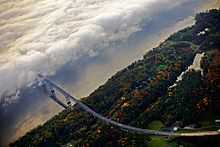Kingston–Rhinecliff Bridge
| Kingston–Rhinecliff Bridge | |
|---|---|
|
Bridge seen from Eastern shore of the Hudson River | |
| Coordinates | 41°58′39″N 73°56′47″W / 41.9776°N 73.94625°WCoordinates: 41°58′39″N 73°56′47″W / 41.9776°N 73.94625°W |
| Carries |
Two lanes of |
| Crosses | Hudson River |
| Locale | Kingston, New York, Rhinecliff, New York |
| Official name | George Clinton Memorial Bridge |
| Maintained by | New York State Bridge Authority |
| Characteristics | |
| Design | Continuous under-deck truss bridge |
| Total length | 7,793 ft (2375 m) |
| Width | 2 lanes with shoulders |
| Longest span | 2 x 800 ft (244 m) |
| Clearance below | 152 ft (76 m) above river |
| History | |
| Opened | February 2, 1957 |
| Statistics | |
| Toll | US$1.50, eastbound only |
 Kingston-Rhinecliff Bridge Location on a map of New York | |
The Kingston–Rhinecliff Bridge or George Clinton Memorial Bridge is a continuous under-deck truss bridge that carries NY 199 across the Hudson River in New York State north of the City of Kingston and the hamlet of Rhinecliff. It was opened to traffic on February 2, 1957 as a two-lane (one in each direction) bridge, although it was not actually complete. Formal opening was May 11, 1957. The original cost was $17.5 million.[1]
The bridge, owned by the New York State Bridge Authority (NYSBA), carries two lanes of traffic and approximately 17,000 vehicles per day. It was designed by David B. Steinman and the builders were Harris Structural Steel and Merritt-Chapman & Scott Corporation, and is the second northernmost, and second newest, of the 5 bridges that NYSBA owns and operates. The bridge has two main spans, since there is an east and west channel in the Hudson River at this point.
Development
Planning for a bridge in this general area to replace the ferry service, which was viewed as sporadic and unreliable, (there were no Hudson bridges for 1/2 hour or more drive time in either direction) began in the early 1940s. The site for the bridge, as originally proposed was between Kingston Point and downtown Rhinebeck, and the design was initially a suspension bridge almost identical in appearance to the Mid-Hudson Bridge. When the site was relocated about 3 miles (4.8 km) northward, there was no stable bedrock for anchorages, so the design was changed to a continuous under-deck truss. Construction commenced in 1954. When the Newburgh-Beacon Bridge was proposed, provisions were inserted in the enabling legislation that construction on that bridge could not commence until the Kingston–Rhinecliff was completed.
Like all NYSBA bridges, the Kingston–Rhinecliff is a toll bridge, with the toll set at $1.50 for eastbound automobiles and other 2 axle vehicles. Westbound traffic is not tolled.
In 2000 the state ceremonially renamed the bridge after George Clinton, New York's first Governor, fourth Vice President of the United States and a resident of the Hudson Valley.[1]



Tolls
A $1.50 toll is collected in the eastbound direction for all cars. E-ZPass users pay a $1.25 toll.
See also
References
- ↑ 1.0 1.1 New York State Bridge Authority. Highland, NY. "The 'George Clinton' Kingston-Rhinecliff Bridge." Accessed 2010-09-13.
External links
| Wikimedia Commons has media related to Kingston–Rhinecliff Bridge. |
- NYCroads: Historic overview
- Toll schedule - NYSBA
- Kingston–Rhinecliff Bridge at Structurae
- Chas H. Sells rehabilitation project information
| |||||||||